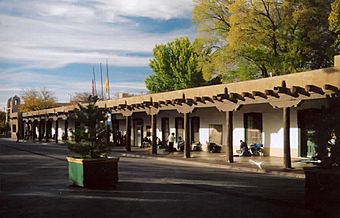Palace of the Governors facts for kids
|
Palace of the Governors
|
|
|
U.S. Historic district
Contributing property |
|

Palace of the Governors
|
|
| Location | 120 Washington Avenue, Santa Fe, New Mexico |
|---|---|
| Area | less than one acre |
| Built | 1610 |
| Architectural style | Territorial Style Pueblo architecture |
| Part of | Santa Fe Historic District (ID73001150) |
| NRHP reference No. | 66000489 |
Quick facts for kids Significant dates |
|
| Added to NRHP | October 15, 1966 |
| Designated NHL | October 9, 1960 |
| Designated CP | July 23, 1973 |
The Palace of the Governors (which means "Palace of the Governors" in Spanish) is a historic building made of adobe (sun-dried earth bricks). It is located in Santa Fe, New Mexico. This special building was constructed in a style called Territorial Style Pueblo architecture.
For hundreds of years, the Palace of the Governors was the main government building for New Mexico. It was first built in 1610 to be the capital of Nuevo México, which was a Spanish territory. It continued to be New Mexico's government center until 1901.
Contents
History of the Palace
Building the Palace
In 1610, Pedro de Peralta became the new governor of Santa Fe de Nuevo México. This territory covered a large area, including much of what is now the southwestern United States. Governor Peralta started building the Palace of the Governors. Some newer research suggests the building might have started a bit later, around 1618.
Changes Over Time
Over the years, the Palace of the Governors saw many changes as the control of New Mexico shifted.
- In 1680, the Pueblo Revolt happened, and Native American groups took control.
- The Spanish returned and took back the Palace between 1693 and 1694.
- In 1821, Mexico gained independence from Spain, and the Palace became part of Mexican rule.
- In 1848, New Mexico became a territory of the United States.
- Finally, in 1912, New Mexico became a US state.
The Palace was first the government center for the Spanish colony of Nuevo Mexico. This colony was very large, including parts of what are now Texas, Arizona, Utah, Colorado, Nevada, and New Mexico. After Mexico became independent, the Palace served the Mexican province of Santa Fe de Nuevo México. When the United States took over, it became New Mexico's first territorial capital.
Famous Writers and the Palace
Lew Wallace, a famous writer, finished writing parts of his well-known book Ben-Hur: A Tale of the Christ in this building. He was serving as the territorial governor in the late 1870s. He later remembered writing important scenes of the novel late at night during a thunderstorm in 1879. He was working by the light of a lamp, worried about the tensions from the Lincoln County War happening at the time.
Restoration and Museum
In 1909, a scientist named Dr. Edgar Lee Hewett asked a young archaeologist, Jesse L. Nusbaum, to help restore the Palace of the Governors. The building had become old and needed repairs. Nusbaum was the first person hired by Dr. Hewett's new organization, the School of American Archaeology (which later became the School of American Research and the Museum of New Mexico).
Nusbaum believed it was important for the Palace's design to fit in with the natural environment. He wrote that "the Palace was begun with an adaptation to climate and atmosphere and had been fitted into the color of earth and sky." He later used this idea when he was in charge of Mesa Verde National Park. The restoration work was finished in the fall of 1913.
The New Mexico territorial legislature created the Museum of New Mexico in 1909. From that time until 2009, the Palace of the Governors was home to the state history museum. In 2009, the New Mexico History Museum opened right next to the Palace. The Palace is now one of eight museums managed by the New Mexico Department of Cultural Affairs.
National Recognition
The Palace of the Governors was recognized as a National Historic Landmark in 1960. This means it is a very important historical place in the United States.
The United States Postal Service even released a special postage stamp featuring the Palace on June 17, 1960. This happened on the opening day of Santa Fe's 350th-anniversary celebration.
{{wide image|Palace of the Governors pano.jpg|900px|A wide view of the Palace of the Governors, showing local artists and craftspeople selling their work.]]

See also
 In Spanish: Palacio de los Gobernadores para niños
In Spanish: Palacio de los Gobernadores para niños
- Oldest buildings in the United States
- National Register of Historic Places listings in Santa Fe County, New Mexico
- List of National Historic Landmarks in New Mexico


